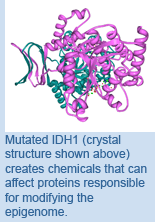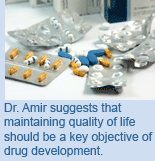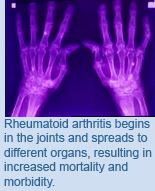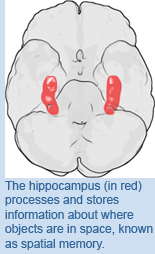
July 2012
Welcome to Net Results EXPRESS
Net Results EXPRESS (NRx) is an award-winning, monthly e-newsletter highlighting medical and scientific breakthroughs, major grants and honours awarded, and other research-related events at UHN. Through NRx you can read about ongoing research at our five research institutes, the Ontario Cancer Institute (OCI), the Toronto General Research Institute (TGRI), the Toronto Western Research Institute (TWRI), the Toronto Rehabilitation Institute (TRI) and the Techna Institute for the Advancement of Technology for Health (Techna). We hope you will find this newsletter informative and helpful. If you have feedback or questions, please contact www@uhnresearch.ca. Christopher J. Paige, PhD, FCAHS |
Leukemia: An Experimental Model for AML Provides New Insights
Mutation of IDH1 was found to cause blood cell development outside the bone marrow, anemia, enlargement of the spleen and an increased number of immature blood cells—events that are characteristic of dysfunctional bone marrow and pre-leukemia development. Interestingly, this mutation led to changes in the epigenome (a number of chemical modifications to the genome that is responsible for control over gene expression) similar to those observed in the human disease. This study is the first experimental model that effectively replicates the physiological and epigenetic changes seen in this disease. “This is the most common mutation in gliomas, specific types of lymphoma and acute myeloid leukemia,” says Dr. Mak. “This model will provide an excellent resource for further investigations into the nature of leukemia and lymphoma, as well as the development of new prognostic and therapeutic approaches.” IDH1-R132H mutation increases murine hematopoietic progenitors and alters epigenetics. Sasaki M, Knobbe CB, Munger JC, Lind EF, Brenner D, Brüstle A, Harris IS, Holmes R, Wakeham A, Haight J, You-Ten A, Li WY, Virtanen C, Reifenberger G, Ohashi PS, Barber DL, Figueroa ME, Melnick A, Zúñiga-Pflücker JC and Mak TW. Nature. 2012 July 4. [Pubmed abstract] This work was supported by the Canadian Institutes of Health Research, the Ontario Ministry of Health and Long-Term Care, National Institutes of Health, the Terry Fox Foundation and The Princess Margaret Hospital Foundation. Dr. Ohashi is a Tier I Canada Research Chair in Autoimmunity and Tumour Immunity. Dr. Mak is a Tier I Canada Research Chair in Inflammation Responses and Traumatic Injury. |
Cancer Care: Drug Development and Maintaining Quality of Life
OCI Clinical Fellow Dr. Saroj Niraula, Clinician Scientist Dr. Eitan Amir, Senior Scientist Dr. Ian Tannock and collaborators examined the results of 38 clinical trials testing new anticancer drugs in a study published in the Journal of Clinical Oncology. The odds of death related to treatment, side effects and treatment discontinuation were higher in the groups receiving new treatments than those receiving older therapy. Furthermore, because clinical trials generally enroll patients without the complicating presence of additional diseases or disorders beyond the cancer to be treated, these results may underestimate the toxicity observed in regular practice. Most large randomized controlled trials are not designed to detect differences in quality of life or toxicity of treatment. Instead, trials are designed to examine efficacy such as how many patients survived their cancer and for how long. Based on those measures, all the trials included in the study were a success with the treatments receiving FDA approval. “Patients’ baseline health characteristics should be considered when choosing a therapy,” says Dr. Amir. “Also, large population-based outcome studies should be encouraged to quantify real-life efficacy and toxicity.” The price we pay for progress: A meta-analysis of harms of newly approved anticancer drugs. Niraula S, Seruga B, Ocana A, Shao T, Goldstein R, Tannock IF, Amir E. Journal of Clinical Oncology. 2012 July 16. [Pubmed abstract] This work was supported by The Princess Margaret Hospital Foundation. |
Rheumatoid Arthritis: Circulating Non-Immune Cells Promote the Spread of Joint Inflammation
Fibrocytes, a rare population of cells that circulate within the body, are recruited to sites of injury where they aid in wound healing. Dr. Fish’s team initially identified fibrocytes in the blood of patients with RA. Subsequent experimental studies showed that when a small number of these fibrocytes are transferred into mice with RA, they rapidly migrated to inflamed joints, where they exacerbate the disease by increasing the recruitment of inflammatory cells to the joint. Fibrocytes were also able to increase the production of proteins known as matrix metalloproteinases (MMPs). Increased expression of MMPs can be destructive as they contribute to loss of cartilage and joint deformation. Dr. Fish’s study reinforces the concept that the progression of RA can be regulated by a non-immune cell. Targeting these circulating fibrocytes may be beneficial in hindering the spread of the disease to non-affected joint tissue. Circulating fibrocytes contribute to the pathogenesis of arthritis. Galligan CL, Fish EN. Arthritis and Rheumatism. 2012 June 21. [Pubmed abstract] This work was supported by the Canadian Institutes of Health Research. Dr. Fish is a Tier I Canada Research Chair in Women’s Health and Immunobiology and a recipient of the 2012 Canadian Society of Immunology Investigator Award. |
Bipolar Disorder: Making Beneficial Therapy More Accessible
In order to improve the accessibility of effective psychotherapies for these patients, TWRI Clinician Scientist Dr. Sagar Parikh compared traditional CBT with a less lengthy and affordable therapy, known as psychoeducation. This group-based therapy costs $180 per subject while CBT costs $1,200 per subject. A wide variety of patients, with varying symptoms and treatment plans, were enrolled in the study to ensure that ’real world‘ conditions were represented. The results showed that psychoeducation was equally effective as CBT at preventing bipolar relapse and improving mood, with no major differences in outcomes reported. Dr. Parikh emphasizes, “This study was the largest clinical trial of bipolar disorder ever conducted in Canada. The results have lead to immediate changes in how bipolar disease is treated, with multiple Canadian institutions now being trained in the new form of psychoeducation therapy.” A randomized controlled trial of psychoeducation or cognitive-behavioral therapy in bipolar disorder: a Canadian network for mood and anxiety treatments (CANMAT) study [CME]. Parikh SV, Zaretsky A, Beaulieu S, Yatham LN, Young LT, Patelis-Siotis I, Macqueen GM, Levitt A, Arenovich T, Cervantes P, Velyvis V, Kennedy SH, Streiner DL. Journal of Clinical Psychiatry. 2012 June. [Pubmed abstract] This work was supported by the the Canadian Institutes of Health Research and the Stanley Medical Research Institute. |
Exercise: Improving Quality of Life in Patients Undergoing Chemotherapy
AML patients initiating chemotherapy undertook sessions consisting of aerobic exercise, weight training and stretching 4-5 times per week. The exercise program was offered for the duration of admission, typically 4-6 weeks. The regime was found to be successfully and safely tolerated by patients and led to a significant improvement in several components of physical fitness. In addition, improvements in a number of important outcomes were observed, including decreased anxiety and fatigue and an overall positive increase in the patients’ quality of life. Commenting on future developments in interventions for AML patients, Dr. Alibhai says, “Future versions of this regime should include nutritional support interventions to counteract the profound malnutrition and weight loss seen in these patients. Combining exercise and nutritional interventions could have a serious positive impact on their lives and the effectiveness of their treatment.” A clinical trial of supervised exercise for adult in patients with acute myeloid leukemia undergoing induction chemotherapy. Alibhai SM, O'Neill S, Fisher-Schlombs K, Breunis H, Brandwein JM, Timilshina N, Tomlinson GA, Klepin HD, Culos-Reed SN. Leukemia Research. 2012 June 20. [Pubmed abstract] This work was supported by the Toronto Rehabilitation Institute, The Princess Margaret Hospital Foundation and Toronto Dominion Securities Inc. |
Computational Neuroscience: The Relationship between Individual Neurons and Population Network Activities in the Hippocampus
Drs. Ho, Skinner and their collaborators used a multifaceted approach consisting of computer simulations, mathematical analyses, experimental analyses and validation to show that low frequency SPAs are due to the existence of particular properties of inhibitory cells and network interactions. Specifically, when excitatory and inhibitory network interactions are balanced, the network can transition from one state to another, allowing SPAs to emerge as part of the inhibitory response. This switching ability occurs if the fast-spiking inhibitory cells have a steep change in firing rate activity and are supported by the network interactions in this regime during hippocampus activation. Using interneuron recordings from mice and rat models, a plot of frequency versus current produced results that were consistent with the model predictions. “This is the first study to have uncovered the precise conditions in a physiological context that promote network multistability,” explains Dr. Skinner. “The fundamental understanding achieved will contribute to hippocampal function and dysfunction understanding from network perspectives, as well as give insight into underlying mechanisms in other brain regions.” Inhibitory networks of fast-spiking interneurons generate slow population activities due to excitatory fluctuations and network multistability. Ho ECY, Struber M, Bartos M, Zhang L, Skinner FK. Journal of Neuroscience. 2012 July 18. [Pubmed abstract] This work was supported by the the Natural Sciences and Engineering Research Council of Canada and the SciNet HPC Consortium. |
 |
![]()
 UHN’s 2011 Research Report, entitled ‘understanding life IMPROVING HEALTH’, was recognized by the League of American Communications Professionals (LACP) with a Gold Award in the 2011 Vision Awards Annual Report Competition. The report was also ranked as one of the Top 10 Canadian Reports and Top 50 Regional Annual Reports (Americas). LACP received more than 5,500 entries in this year's competition, representing more than 24 countries and 800 organizations.
UHN’s 2011 Research Report, entitled ‘understanding life IMPROVING HEALTH’, was recognized by the League of American Communications Professionals (LACP) with a Gold Award in the 2011 Vision Awards Annual Report Competition. The report was also ranked as one of the Top 10 Canadian Reports and Top 50 Regional Annual Reports (Americas). LACP received more than 5,500 entries in this year's competition, representing more than 24 countries and 800 organizations.Written and designed by UHN Research Communications, with support from other RSS departments including Research Financial Services, Research Program & Planning Analysis and Research Facilities Planning, this report competed in the "Health Care - Providers and Services" category and received a total score of 98 out of a maximum 100 points. “The level of creativity exhibited in the report judged for UHN Research Communications is outstanding,” says Christine Kennedy, LACP Managing Director.
To view the 2011 report, click here.
 Congratulations to OCI Clinician Scientist Dr. Michael Baker and OCI Senior Scientist Dr. Frances Shepherd for receiving the Queen’s Diamond Jubilee Medal. The medal, created to mark 60 years of The Queen’s reign, is given to Canadians in honour of their contributions to society and their achievements that have brought prestige to Canada.
Congratulations to OCI Clinician Scientist Dr. Michael Baker and OCI Senior Scientist Dr. Frances Shepherd for receiving the Queen’s Diamond Jubilee Medal. The medal, created to mark 60 years of The Queen’s reign, is given to Canadians in honour of their contributions to society and their achievements that have brought prestige to Canada.Dr. Baker was awarded for his research into the diagnosis and treatment of leukemia. Dr. Shepherd was honoured for her many contributions in the field of lung cancer research, most notably her pioneering work in improving treatment strategies and outcomes of patients with lung cancer.
 TWRI Senior Scientist Dr. Andres Lozano received the prestigious Pioneer in Medicine Award from the Society of Brain Mapping and Therapeutics (SBMT), in recognition of his groundbreaking research in the use of deep brain stimulation in the treatment of depression, obesity and Alzheimer's disease. This award is presented to individuals who have significantly contributed to scientific advancement in the fields of medicine and image-guided therapy through a multidisciplinary approach.
TWRI Senior Scientist Dr. Andres Lozano received the prestigious Pioneer in Medicine Award from the Society of Brain Mapping and Therapeutics (SBMT), in recognition of his groundbreaking research in the use of deep brain stimulation in the treatment of depression, obesity and Alzheimer's disease. This award is presented to individuals who have significantly contributed to scientific advancement in the fields of medicine and image-guided therapy through a multidisciplinary approach.SBMT is a non-profit society organized for the purpose of encouraging basic and clinical scientists who are interested in areas of brain mapping, engineering, stem cell, nanotechnology, imaging and medical devices to improve the diagnosis, treatment and rehabilitation of patients afflicted with neurological disorders.
Support for Dr. McCart will support her research into oncolytic viruses—viruses engineered to specifically target cancer cells, leaving healthy cells intact. Her project involves improving the use of viruses so that they can one day be used in the clinic to treat cancer patients.
This funding will enable Dr. Muthuswamy to use a 3-D biological model he created to unravel the mystery of how pancreatic cancer begins to develop deep within the organ’s duct system. “Cells in our body exist as 3-D tubes and vessels, so if you study them in a flat layer—like in a petri dish—you will not be able to ask all the right questions. These models are much more realistic, much closer to what actually happens in our bodies,” says Dr. Muthuswamy.
 UHN’s Arthritis & Autoimmunity Research Centre (AARC) Director and TGRI Senior Scientist Dr. Eleanor Fish was awarded the Canadian Society for Immunology (CSI) 2012 Investigator Award. This award was given to Dr. Fish in recognition of her outstanding accomplishments as a researcher and mentor in immunology throughout her career.
UHN’s Arthritis & Autoimmunity Research Centre (AARC) Director and TGRI Senior Scientist Dr. Eleanor Fish was awarded the Canadian Society for Immunology (CSI) 2012 Investigator Award. This award was given to Dr. Fish in recognition of her outstanding accomplishments as a researcher and mentor in immunology throughout her career. Founded in 1966, CSI’s mandate is to foster and support immunology research and education throughout Canada. Previous UHN winners of this award include OCI Senior Scientist Dr. Pamela Ohashi.
Congratulations Dr. Fish!
Feedback
Net Results EXPRESS is brought to you by UHN Research Communications. We hope you have enjoyed receiving this message. If you have any feedback, please email www@uhnresearch.ca.
To access archived issues of Net Results EXPRESS, visit uhnresearch.ca/news/netresultsexpress
Some images adapted from the image archives of stock.xchng.ca, Yuan Lew and Wikipedia. Mutations in the gene isocitrate dehydrogenase 1 and 2 (IDH1/2) are frequent in brain cancers, some lymphomas and acute myeloid leukemia (AML) but the exact role of these mutations in this disease remains a mystery. UHN's Campbell Family Institute for Breast Cancer Research Director and OCI Senior Scientist Dr.
Mutations in the gene isocitrate dehydrogenase 1 and 2 (IDH1/2) are frequent in brain cancers, some lymphomas and acute myeloid leukemia (AML) but the exact role of these mutations in this disease remains a mystery. UHN's Campbell Family Institute for Breast Cancer Research Director and OCI Senior Scientist Dr.  Anticancer drugs often carry a risk of causing various unwanted effects such as vomiting, diarrhea, fatigue and shortness of breath. Patients will, at times, choose to discontinue their treatment as a result of the serious adverse events caused by the medications they’re taking.
Anticancer drugs often carry a risk of causing various unwanted effects such as vomiting, diarrhea, fatigue and shortness of breath. Patients will, at times, choose to discontinue their treatment as a result of the serious adverse events caused by the medications they’re taking. Rheumatoid arthritis (RA) often begins in a single joint where immune cells—mainly T cells—secrete proteins that induce joint injury. Ongoing recruitment of T cells to inflamed joints then leads to disease progression. A recent study by Arthritis & Autoimmunity Research Centre Director and TGRI Senior Scientist Dr.
Rheumatoid arthritis (RA) often begins in a single joint where immune cells—mainly T cells—secrete proteins that induce joint injury. Ongoing recruitment of T cells to inflamed joints then leads to disease progression. A recent study by Arthritis & Autoimmunity Research Centre Director and TGRI Senior Scientist Dr.  Worldwide, approximately 1 in 100 people suffer from bipolar disorder. Current medications show limited effectiveness, with relapses and ongoing depression commonly occurring. Thus, a number of complementary psychotherapies are employed. One of the most established therapies, known as cognitive-behavioural therapy (CBT), helps patients to challenge negative thought patterns and habits leading to improved mood and wellbeing. Although CBT has been shown to prevent bipolar relapse and related depression, treatment is lengthy, expensive and often out of reach for some patients.
Worldwide, approximately 1 in 100 people suffer from bipolar disorder. Current medications show limited effectiveness, with relapses and ongoing depression commonly occurring. Thus, a number of complementary psychotherapies are employed. One of the most established therapies, known as cognitive-behavioural therapy (CBT), helps patients to challenge negative thought patterns and habits leading to improved mood and wellbeing. Although CBT has been shown to prevent bipolar relapse and related depression, treatment is lengthy, expensive and often out of reach for some patients.  Treatment of acute myeloid leukemia (AML) requires multiple cycles of intensive chemotherapy. These cycles are associated with physical inactivity and fatigue, leading to a decline in physical condition and quality of life, which may reduce a patient’s ability to tolerate further chemotherapy. To counteract these negative effects, a clinical trial led by TRI Scientist and TGRI Senior Scientist Dr.
Treatment of acute myeloid leukemia (AML) requires multiple cycles of intensive chemotherapy. These cycles are associated with physical inactivity and fatigue, leading to a decline in physical condition and quality of life, which may reduce a patient’s ability to tolerate further chemotherapy. To counteract these negative effects, a clinical trial led by TRI Scientist and TGRI Senior Scientist Dr.  The hippocampus is the region of the brain responsible for processing a number of important functions, including memory formation and storage. Hippocampal activity is controlled in part by inhibitory cells and the networks they comprise. The individual inhibitory cells fire at high frequencies but collectively produce activities at significantly slower rhythms—termed slow population activities (SPAs). While the underlying mechanisms that help to coordinate this network are poorly understood, TWRI Senior Scientist Dr.
The hippocampus is the region of the brain responsible for processing a number of important functions, including memory formation and storage. Hippocampal activity is controlled in part by inhibitory cells and the networks they comprise. The individual inhibitory cells fire at high frequencies but collectively produce activities at significantly slower rhythms—termed slow population activities (SPAs). While the underlying mechanisms that help to coordinate this network are poorly understood, TWRI Senior Scientist Dr.